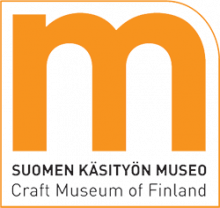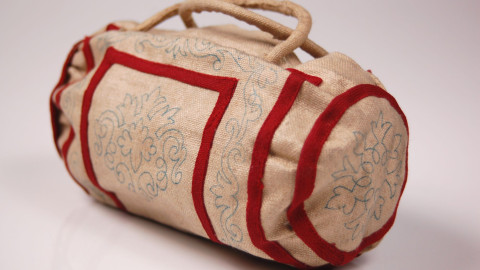History of Collections in the Craft Museum of Finland
Founded on 14 December 1888 under the name of the State Museum of Crafts and initially operating under the auspices of the Finnish Association of the Arts and Crafts, the Craft Museum on Finland and the formation of its collections have been guided at different times by the values and attitudes of the era. You can read a summary of the different phases of the museum on its own page.
Elevating the profile of home industry with a museum
In the 1890s, the General Home Industry Association was founded in Finland at the same time as in the other Nordic countries to promote national home industry. The lean years of the 1860s had weakened rural living conditions, and the beginning industrialisation had reduced interest in home industry. Improving craftsmanship was seen as a solution to the poverty problem that arose in society. The association's mission statement emphasised the attitude in favor of home industry and the improvement of handicraft skills among the people.
Inspired by the idea of nationalism of the era, the vision of the convened group of experts was a kind of multifunctional center for science, art and industry, which would include a home industry office, a network of home industry associations, home industry schools, shops and a museum. Lauri Kuoppamäki (from 1920 Mäkinen), an active advocate of the idea of home industry, was invited to initiate the activity.
The aim of the museum was to collect a comprehensive and pedagogical collection that would include domestic home industry samples from different eras, tools and raw materials used to make them, and photographs. The collection was divided into two sections: a historical-ethnological section and a section containing new home industry products (Heinänen 1998, 59-61.) Examples of domestic home industry were obtained from competitions and exhibitions, which were advertised in handicraft and home industry magazines. The collection continued to grow this way until the 1920s. In 1926 the museum's exhibition activities practically ceased and the collections were packed into boxes due to lack of space. However, the library collection, which had been systematically accumulated from 1908 onwards, continued to be added to on a fairly regular basis until 1938.
Clarifications to areas of collection
When the Home Industry Museum of Finland restarted (1982-1983) its work with collections, traditional and new methods of museum work were combined. According to the instructions of the founding group of the Ministry of Education, unrecorded areas had to be supplemented as far as possible, and objects, models, work tools, materials and photographic material had to be quickly collected in the museum's collections to fill in the "black holes" in the collections that had arisen over the decades. The museum was considered to promote product design in the field, especially by offering stimuli, inspiration and passing on information and advice. (Hirvi, 1983 and 2012.) The artefact and photo collections were mainly accumulated thanks to donations and represented material from the period between the world wars or the period of depression and reconstruction after the World War II. (Kotilainen, 1998).
The object of the museum's research and documenting activities was defined as “the history and present of handicrafts and home industry, as well as related phenomena”. Complementary work was started by interviewing influential persons in the home industry and gathering information about home industry associations, counseling centers and educational institutions in the field.
Right after the "new beginning", the museum did active contemporary documentation work by documenting coastal handicraft skills, such as information about the production of Korsnäs sweaters and Kruunupyy reed works. In many research and documenting projects, the focus was on specific materials, such as sheep's wool, stonework and linen. The knowledge and skills of the artisans were documented by photographing and interviewing. In the 1990s, the "Many Faces of Craftsmanship" writing competition was also organised, the theme of which was continued by documenting craftspeople working in different parts of Finland.
The national costume model collection of the National Costume Council established by the Kalevala Women’s Association, the Central Association of Domestic Crafts, the Friends of Finnish Folk Dance, Finnish Local Heritage Federation, the Finnish Youth League, Finlands Svenska Folkdansring and the later joined Karelia Federation was handed over to the National Costume Center of Finland, which started its operations in 1991.
Documenting disappearing professions
At the end of the 1990s, efforts were made to document disappearing craft professions, such as saddle and ski smith, brickmaker, weaver and basket weaver, and in the first decade of the 21st century, emphasis was placed on documenting regional contemporary craftsmanship. Field trips were carried out e.g. for the archipelago and coastal area (2002-2003), Åland (2004) and the reindeer husbandry area of Northern Finland (2005-2007). The craftspeople's everyday life and craft skills were documented by interviewing, photographing and videotaping.
In the 2010s, the subjects of documentation have been, for example, national costume artisans and the current Taito Group and its regional associations.
The decade has also challenged museums to several situations that are demanding in terms of time, space and financial resources – the so-called rescue documentation, where the irreversible changes to the traditions and key players in the craft sector have suddenly threatened to destroy part of Finnish craft culture.
Phenomenon-focused documenting with students
The museum has been collaborating with students in the University of Jyväskylä, Department of Museology since 1995, but more actively since the early 2000s. Each year, the students, either independently or in small groups, have worked together with museum staff to make a contemporary documenting of a current phenomenon or theme. Fieldwork has consisted of interviews, photography, and object acquisition. By 2018, a total of around 50 documenting projects have been made.
Summaries of the documenting have been uploaded online in 2015 and 2016, and since 2016 students have been uploading the summaries of their recordings themselves. The students' documenting are not only kept in the archive waiting for future researchers, but also can be viewed by the general public. The documenting work of museology students supports the role of the Craft Museum of Finland as a national museum of specialised knowledge. The students bring a fresh perspective to the documentation and the collaboration will continue in the future.
Documenting priorities now and in the future
The documenting priorities of the Craft Museum of Finland in the late 2010s and 2020s still include documenting the work of key people and artisans in the field of handicrafts and textile art through video recording, interviews and acquisitions. Mapping the boundaries of the craft field and thinking about the future are an essential part of the museum's collection and documenting activities.
National costumes as part of collections
The National Costume Center of Finland, together with the National Costume Panel, continues the work of the National Costume Council, which ceased operations in 2010. National Costume Center is responsible for the research, documentation, recording, education, advice and publication of national costumes, that are inspired and modelled by the 18th-19th century folk costumes, as well as assembling and inspecting new national costumes to match their models. The National Costume Center also manages the extensive research archive compiled by the Council, which includes more than 10,000 slides of national costumes and their parts, as well as national costume images in photographs and watercolours.
More information
Marjo Ahonen
curator, collections
tel. +358 50 566 2187
marjo.ahonen [at] jyvaskyla.fi

